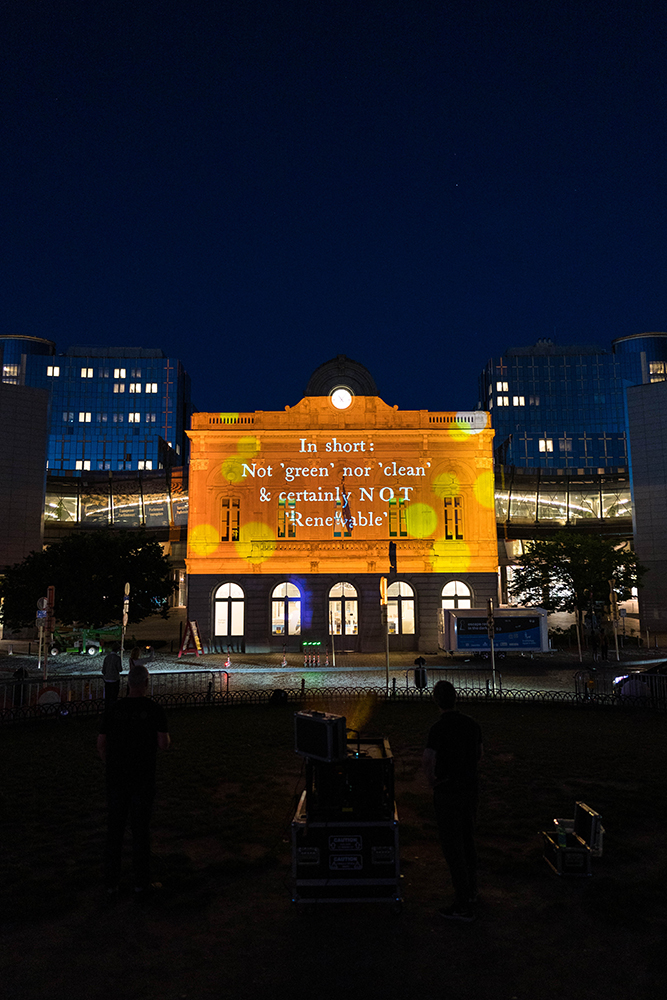Wake-up call for European Parliament by light show
Industry Committee called on to listen to science and society: No Burning biomass
BRUSSELS | On Sunday night July 10, the Dutch Comité Schone Lucht1comiteschonelucht.nl called on the industry committee of the EU parliament to stop burning biomass for energy. The Dutch projected the message, on behalf of the International Coalition2International Coalition against Biomass Burning exist of about 30 European NGO’s protesting against the burning of forest biomass for energy. The current action is the umpteenth public campaign that has been carried out in the last years, by the Clean Air Committee (CSL – 1) together with the international coalition against burning biomass (see also Forest Defenders Protest). CSL previously brought on behalf of the coalition together with Birdlife Europe and WeMOVE Europe, more than 300,000 signatures to the headquarters of Frans Timmermans in Brussels, vice president of the EU Commission and promoter of woody biomass for energy. In collaboration with other NGOs and action groups, from both the source countries Estonia (Save Estonia’s Forests, Estonian Forest Aid; Estonian Fund for Nature), Sweden (Save the Forests), Hungary (WildEurope), Finland (Ei polteta tulevaisuutta – kampanja), Slovakia (WOLF), Poland (Workshop for All Beings – Pracownia), Romania (Green Squad), Austria, France (Canopee), US (Dogwood Alliance, Forest Defenders, PFPI, NRDC ) as well as those that import the wood for biomass burning; including Netherlands (CSL), Belgium (Fern, Birdlife), UK (Biofuelwatch), Denmark (NOAH), Germany (Robin Wood, NABU) and Italy (Green Impact), they organized numerous (street) actions in Brussels. The Netherlands plays a remarkable role in the biomass debate: not only was it the first country to stop new subsidies last spring, the Dutch are also the second largest wood importers of wood pellets for burning biomass in the world. Major driver of burning biomass is the Dutchman, Frans Timmermans, vice president of the EU Commission and GreenDeal, who made it possible to exempt billions of biomass subsidies (17.5 billion EU euros on annual basis). At the same time, no turning point has been greater than in Dutch society. Due to the ongoing campaign from CSL, awareness and resistance to biomass grew in Dutch society. Where 4 years ago biomass was still seen as a solution, there is now growing consensus within science, politics and society that biomass is a problem that must be stopped as soon as possible (SER, 2020). against the burning of biomass, via a light show on Place du Luxembourg and the Triumphal Arch in the Cinquantenaire Park. The message that was projected on various buildings went viral immediately after the light show last night after 11 p.m. and immediately became a hype with the hashtag #stopfakerenewabels.




Key points
Next Wednesday 13 July the European Parliament’s Industry, Research and Energy (ITRE) Committee will vote amendments to revise the Renewable Energy Directive (RED). On some key issues, including whether to stop support for burning forest biomass, their vote will be decisive. Key points include votes related to:
- stopping subsidies and incentives for burning woody biomass for energy;
- the application of the so-called ‘cascade principle’3with which the pressure on forests can be reduced by first using biomass for high-value applications (such as construction material for construction). Combustion of biomass is the very last step in the cascade principle.;
- the sustainability criteria and forest protection measures to limit future damage to our forests4by demanding protection for primary forests, natural forests and forests with biodiversity through targeted conservation measures; by banning the reclamation of forested peatlands for the harvest of forest biomass and by enforcing important protections in European nature legislation such as nature protection in the Birds, Habitats and Water Directives;
The Coalition wants the ITRE Committee to support the positive improvements voted by the Environment Committee last May, which help to protect forests from over-logging for energy use. I.e. a call for rejection of the negative amendments proposed in ITRE to weaken or delete the sustainability criteria.


Strong request
In the vote in the ITRE Committee the parliamentarians have the opportunity to protect forests, which are currently being damaged by excessive logging. The damage is largely the result of incentives for biomass combustion as so-called sustainable energy in the existing RED. It is estimated that about half of the total forest harvest in the EU is now burned to generate energy5www.birdlife.org/news/2022/05/12/press-release-new-report-industries-dodge-12-billion-euro-bill-annually-due-to-emissions-loophole-for-biomass.
The coalition strongly urges to vote in favor of the above, so that the ongoing loss of biodiversity is stopped, and CO2 is retained in forests to achieve EU climate goals. The annual €12 billion in biomass subsidies under the RED, and an additional €12 billion in free CO2 allowances under ETS for biomass combustion (4), can be invested in genuine renewable energy sources such as solar, wind and geothermal energy. And subsequently with a long lifespan. This instead of giving taxpayers’ subsidies to biomass plants to burn trees for energy (Comite Schone Lucht).
Comité Schone Lucht
The coalition asks the members of the ITRE Committee to use their vote to protect our forest and future.
- 1
- 2International Coalition against Biomass Burning exist of about 30 European NGO’s protesting against the burning of forest biomass for energy. The current action is the umpteenth public campaign that has been carried out in the last years, by the Clean Air Committee (CSL – 1) together with the international coalition against burning biomass (see also Forest Defenders Protest). CSL previously brought on behalf of the coalition together with Birdlife Europe and WeMOVE Europe, more than 300,000 signatures to the headquarters of Frans Timmermans in Brussels, vice president of the EU Commission and promoter of woody biomass for energy. In collaboration with other NGOs and action groups, from both the source countries Estonia (Save Estonia’s Forests, Estonian Forest Aid; Estonian Fund for Nature), Sweden (Save the Forests), Hungary (WildEurope), Finland (Ei polteta tulevaisuutta – kampanja), Slovakia (WOLF), Poland (Workshop for All Beings – Pracownia), Romania (Green Squad), Austria, France (Canopee), US (Dogwood Alliance, Forest Defenders, PFPI, NRDC ) as well as those that import the wood for biomass burning; including Netherlands (CSL), Belgium (Fern, Birdlife), UK (Biofuelwatch), Denmark (NOAH), Germany (Robin Wood, NABU) and Italy (Green Impact), they organized numerous (street) actions in Brussels. The Netherlands plays a remarkable role in the biomass debate: not only was it the first country to stop new subsidies last spring, the Dutch are also the second largest wood importers of wood pellets for burning biomass in the world. Major driver of burning biomass is the Dutchman, Frans Timmermans, vice president of the EU Commission and GreenDeal, who made it possible to exempt billions of biomass subsidies (17.5 billion EU euros on annual basis). At the same time, no turning point has been greater than in Dutch society. Due to the ongoing campaign from CSL, awareness and resistance to biomass grew in Dutch society. Where 4 years ago biomass was still seen as a solution, there is now growing consensus within science, politics and society that biomass is a problem that must be stopped as soon as possible (SER, 2020).
- 3with which the pressure on forests can be reduced by first using biomass for high-value applications (such as construction material for construction). Combustion of biomass is the very last step in the cascade principle.
- 4by demanding protection for primary forests, natural forests and forests with biodiversity through targeted conservation measures; by banning the reclamation of forested peatlands for the harvest of forest biomass and by enforcing important protections in European nature legislation such as nature protection in the Birds, Habitats and Water Directives
- 5
